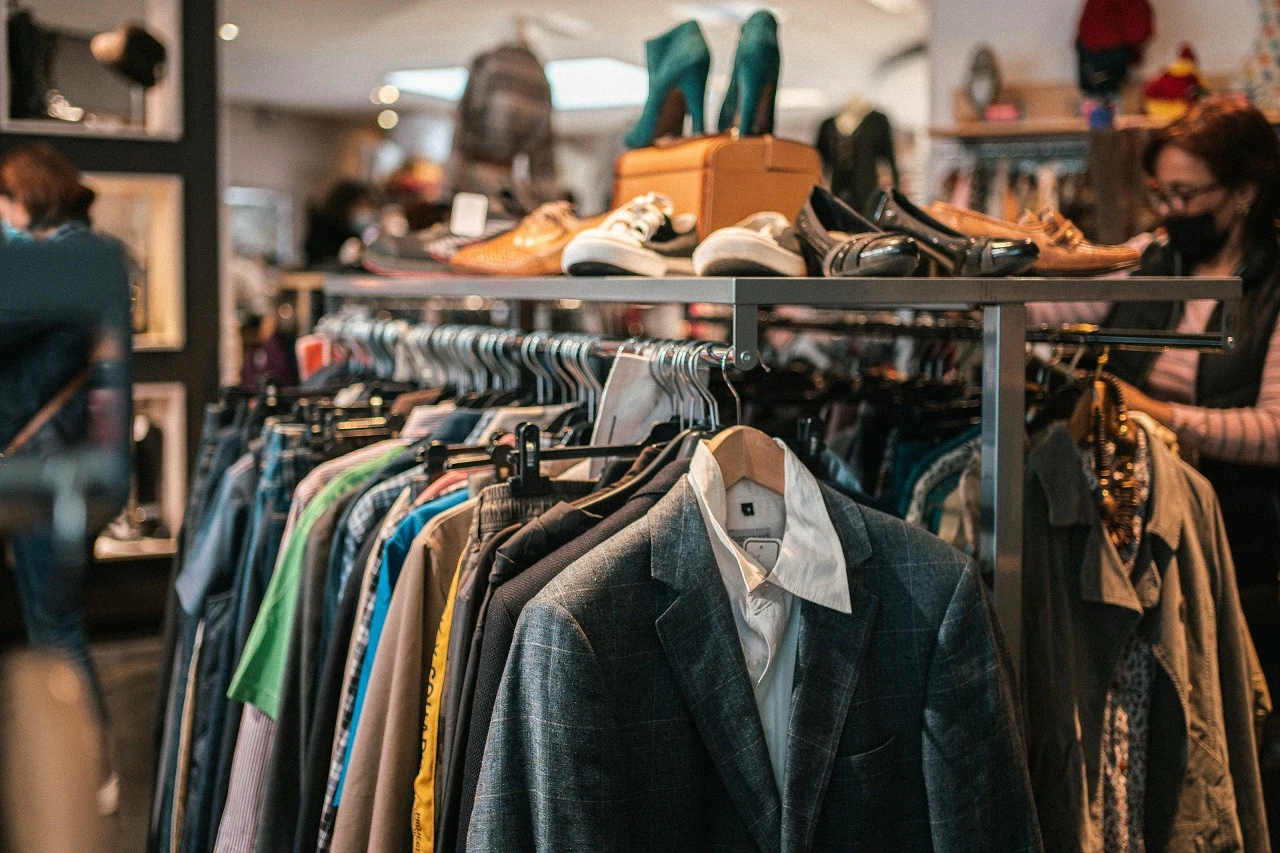
Ever spotted someone wearing designer clothing and wondered how they can possibly afford it? Well, here's a little secret – they might be savvy thrift shoppers. High-end thrifting has become huge over the past few years, and honestly, it's changing the way many of us think about fashion and home decor overall.
Beyond Your Grandma's Thrift Shop
Let's be real – when someone mentions "thrift store," what comes to mind? Musty rooms filled with outdated clothes and chipped dishes? Well, throw that mental image right out the window. Today's high-end thrift stores are nothing like the cluttered charity shops of yesteryear.
Modern upscale thrift stores – occasionally called consignment boutiques or resale boutiques – are patient in choosing what they offer for sale. They are picky about what makes the cut onto their racks and shelves. Some even have strict acceptance policies, accepting only the best by high-end designers.
"The first time that I ever went to a designer consignment store, I couldn't believe my eyes," recalls Melissa, a native Bostonian turned thrift shopper. "I bought a barely worn Burberry trench coat for $85 that would have cost well over $1,000 if it were brand new. Addicted from day one!"
Why High-End Thrifting Has Taken Off
So what's behind the thrifting mania? Various factors have combined to make it the perfect storm:
Sustainability concerns have pushed most consumers to consider secondhand first. The eco-footprint of fast fashion becomes increasingly impossible to ignore, and buying second-hand keeps good things from filling up landfills.
Economic considerations play a significant role as well. Who wouldn't wish to look like a million dollars without spending nearly that much? With inflation tightening wallets, more and more consumers are looking for creative ways to stretch their dollars.
Social media has also made thrifting a fashionable hobby that's popularized far and wide. Influencers share their "thrift hauls" every day, showing incredible treasures and inspiring millions to shop at thrift stores.
How to Find Hidden Gems Near You
Discovering these treasure troves isn't always a straightforward process. Unlike big retail chains, upscale thrift stores often don't have enormous advertising budgets. They're sometimes hidden in plain sight, wedged between other shops or in nondescript neighborhoods.
Here are some proven ways to locate them:
Attempt to search on the internet with targeted terms such as "designer consignment," "luxury resale," or "high-end thrift" and your location. This yields more targeted results than just searching for "thrift stores."
Inquire with hip friends where they go to thrift. Word of mouth remains prevalent in thrifty groups, and word of mouth will usually yield the best-kept secrets.
Search social media, especially Instagram and Facebook. A few high-end thrift stores have lively pages where they list new stock and limited-time sales.
Look on resale apps like Mercari or Poshmark, then follow up with sellers on whether they carry a physical storefront. Most online sellers also maintain brick-and-mortar stores.
"I found my favorite of all time upscale thrift store by accident from a compliment at a coffee shop," says Carlos, a self-touted Chicago thrifter. "This lady was complimenting me on my jacket, and I told her that it was a thrift, and she just told me her little secret. That store has been a favorite of mine for three years now!"
So What Makes a "High-End" Thrift Shop, Anyway?
Not all secondhand shops are created equal. A few characteristics distinguish truly upscale thrift shops from run-of-the-mill resale shops:
Their inventory focuses on designer and high-end brands. Yes, you might find the occasional Target score, but the racks actually do contain recognized luxury brands.
Quality control is strict. Most pieces have little wear and tear, and most still have tags attached to them from when they left the factory. Stains, tears, or evidence
High-End Thrift Store FAQs
What is considered a high-end thrift store?
A high-end thrift store, also known as a consignment boutique or high-end resale shop, is a boutique that sells top-quality, designer, and luxury brand merchandise at discounted prices. In contrast to other thrift shops, these boutiques painstakingly sort through their merchandise, typically only taking in high-quality pieces in near-new condition. They carry brands you'd see in department stores and designer boutiques, have a more upscale shopping atmosphere with neat displays, and usually have educated sales staff who can authenticate luxury items. Prices are higher than at average thrift shops, but less than at retail.
Where can I find luxury thrift stores?
Upscale thrift stores typically are found in upscale neighborhoods, shopping districts, and higher-income zip codes. Search online using terms like "designer consignment," "luxury resale," or "upscale thrift store" and your city or zip code. Social media, especially Instagram, are excellent resources since upscale thrift stores tend to list their items online. Yelp and Google Maps apps allow you to look up reviews from other consumers. Additionally, fashion-forward cities like New York, Los Angeles, Chicago, Miami, and San Francisco will typically have numerous high-end thrift shops.
Is Buffalo Exchange high-end?
Buffalo Exchange falls within a middle tier between low-end thrift stores and high-end consignment shops. Buffalo Exchange is not technically high-end but does carry some designer and high-end brands as well as generic ones. Their buying is selective, geared towards trendy and quality products over strictly designer labels. The inventory by store is vastly different—the stores in trendier or richer areas have higher-end brands. Buffalo Exchange can only be likened to a tastefully curated used store who, at times, has the high-end leftovers at bargain prices along with their more mainstream fare.
What is the difference between a thrift store and a consignment store?
The primary difference between thrift stores and consignment stores is their business model and source of inventory. Thrift stores primarily sell donated items, with proceeds frequently going to charitable causes. They typically accept large quantities of items regardless of brand or condition. Consignment stores, however, sell for the individual owner, sharing the profit when products are sold (usually 40-60% to the original owner). Consignment stores are pickier, only taking products with high quality and fashion standards. They typically have higher-end merchandise, more boutique-like shopping ambiances, and prices than an average thrift store.
What is the best day to go thrift shopping?
The absolute best thrift store shopping day can vary from store to store but does follow general trends. Most of the high-end consignment and thrift stores restock on either a Wednesday or a Thursday before weekend traffic. Monday morning can offer
🛍️ Thrift Store Shopping FAQ for Deal Seekers & Budget Buyers
1. Why are thrift store prices going up lately?
Many thrift stores have become more aware of item value due to reselling trends. Increased demand, inflation, and rising operational costs are also factors.
2. What are the best days to shop at Goodwill for deals?
Typically, Monday or Tuesday mornings offer the best picks after weekend donations are processed. Some stores have weekly color tag sales — check locally!
3. Is it worth it to buy electronics from thrift stores?
It can be, but always test before buying (if possible) or ask about return policies. Stick with simple, low-risk items like headphones, lamps, or DVD players.
4. How do I find high-end brands at thrift stores?
Search in affluent neighborhoods, learn brand tags, and check clothing fabric/materials. Apps like Poshmark or Google Lens help with brand recognition.
5. Which thrift stores have discount days?
Many like Goodwill, Salvation Army, and local charities run weekly tag sales, senior discounts, or student days. Ask staff or check their website/socials.
6. How do I know if a thrift store item is a good deal?
Compare prices online using apps like eBay, Amazon, or Google Shopping. Look for quality brands, minimal wear, and original tags.
7. Are there apps that show thrift store finds near me?
Yes! Try ThriftFinder, Yelp, or Google Maps with reviews. Apps like Depop or OfferUp can show what’s trending locally.
8. How can I flip thrift store items for profit?
Start with popular categories: clothing, electronics, books, and small furniture. Clean, take great photos, and sell on eBay, Facebook Marketplace, or Mercari.
9. What’s the difference between consignment and thrift stores?
Consignment stores sell items on behalf of owners and share profits. Thrift stores usually accept donations and profits go to charity.
10. Why don’t some thrift stores have changing rooms?
Due to space limits, theft prevention, or COVID protocols. Always wear fitted clothing if you want to try things on over your clothes.
11. How do I sanitize clothes from a thrift store?
Wash in hot water, use vinegar or disinfectant laundry additives, or dry clean delicate items. Steamers can also help kill bacteria.
12. Should I shop thrift stores or Amazon return stores?
Thrift stores are better for unique finds and clothing. Amazon return stores are great for electronics, tools, and boxed goods — often cheaper but less curated.
13. Can you return items to a thrift store?
Policies vary. Most thrift stores are final sale, but some allow exchanges or store credit. Always ask before buying.
14. Which thrift stores are best for furniture?
Look for Habitat for Humanity ReStores, Salvation Army, or independent charity shops. Visit often for the best selection.
15. What are the best thrift store hacks for finding hidden gems?
- Go early in the week
- Shop off-season items (e.g. winter coats in summer)
- Check behind racks and on high shelves
- Look for overlooked sections (e.g. kid’s books for rare finds)
16. Why do some thrift stores smell weird?
Old items absorb smells (smoke, mildew). The mix of materials, storage conditions, and age of inventory can create that classic “thrift store scent.”
17. How often do thrift stores restock?
Most restock daily, but Tuesday and Friday mornings often have the freshest inventory after sorting donations.
18. What does the color tag mean at thrift stores?
Stores like Goodwill use color tags to mark discount days. For example, red tags = 50% off on Mondays. Signs in-store will tell you the current deal.
19. Best thrift stores in [city] for families on a budget?
Search “[city] + best thrift stores for families” on Google or Yelp. Look for stores that have kid sections, bundle deals, and are clean/organized.
20. How to tell if a thrift item is vintage or just old?
Check tags, stitching, and brand history. Apps like Google Lens or online vintage guides help. True vintage often has higher-quality craftsmanship.

MOe
Crafting engaging narratives that spotlight the unique shopping experience of bin stores.